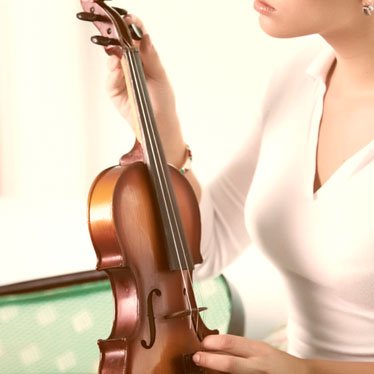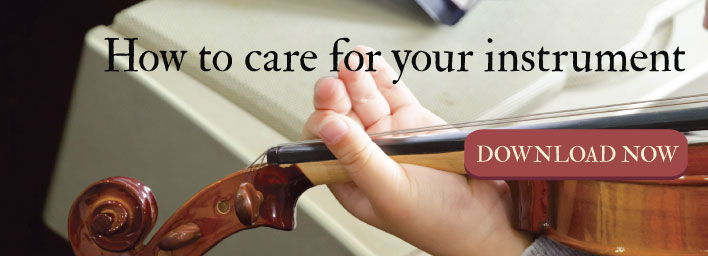Teaching Children To Care For A Violin

Taking care of a violin
As a music instructor, finding applicable ways to teach children to care for their instruments is part of the landscape. Building and nurturing a love of music in students of all ages is a fulfilling, yet demanding profession. But, with young children, it’s of utmost importance that proper care for violin is stressed repeatedly.
Since violins are susceptible to damage if fluctuations in humidity and temperature changes are ignored or if too much pressure is brought to bear on the parts, children must be taught proper instrument care and maintenance in addition to music notation, fingering, and proper bowing techniques.
As you know, a neglected violin won’t resonate (vibrate) properly, which will make it more difficult for the child to learn and be excited by his or her progress. This list examines the most common problems created by neglect, and a few ideas that will help make it easy to show why care for violin is so important.
Environmental Effects
North America has many regions that undergo severe changes in temperature and humidity, relative to the seasons. Wood instruments, such as the violin, are vulnerable to those changes and will expand and contract accordingly, which often leads to open seams or cracks. Students (and teachers) can minimize the problems by:
- Controlling the humidity levels in their practice areas (homes/rooms) with portable humidifiers. Cool mist, steam, and evaporative models are a relatively inexpensive fix.
- Increased humidity in the summer can be reduced by proper air conditioning.
- Never, ever leaving your violin in an empty car!
- In-case humidifiers also offer a great way to maintain proper levels of humidity, and are just the thing for storing your violin for lengthy periods of time (along with following humidifier instructions).
Pegs, Bridge, and Strings
Let's take a look at a few parts of the voilin and how you should take care of them.
Pegs—stiff or loose tuning pegs can happen from humidity changes, poor fit, or simple improper winding. The winding problem is fixed by correcting the manner of the wound string. Stiffness can be solved by lowering the humidity or applying an appropriate peg lubricant, but loose or slipping pegs should be refitted by a luthier.
To wind the peg properly:
- Insert the ball (nub) end of the string into the tailpiece so that the string comes over the top.
- Now that the the string is anchored, bend the peg end of the string so that it forms an approximate 1/2 inch right angle ("L" shape). This will help you thread and wind it properly on the peg.
- Thread the string through the peg hole and rotate the peg so that the hole is now facing the scroll of the violin. Now the string is setting securely in the peg.
- Gently apply pressure by holding the string taught in the opposite direction of the peg (for example, if the peg is located on the right side of the fingerboard, gently pull towards the left), and wind the string for two full turns around the peg. This will wind the string away from the peg hole (away from the peg head).
- Now, shift directions by angling the string back towards the peg side of the fingerboard and continue winding. The string should cross over the original two wraps and wind smoothly and neatly without bunching. Keep winding it until the string has enough tension to remain seated in the tailpiece.
- Winding strings properly will help maintain and care for violin pegs.
Strings—should be replaced every 6-12 months depending on the frequency of use. You want your students to be able to create the best possible sounds, but for that to happen, string replacements are vital. String replacement should be conducted one string at a time to prevent the bridge from shifting or being damaged, or the soundpost from slipping out of place.
Bridge—this very delicate part (the thin, upright piece of wood in the middle of the violin) needs special attention. Since it isn’t attached to the table (body) of the violin, it depends on the pressure of the strings to keep it seated properly. Over time, it can begin to lean. Teach students to periodically check the upright position of the bridge to see if they’ll need you to help them gently ease it back into position. Extremely warped bridges need to be replaced by a professional luthier.
Cleaning and Repairs
It’s a great idea to stress the importance of regular cleaning and care for violin by having students wipe away excess rosin dust from the body and strings with a dry cloth after every practice session.
Care for violin repairs that should be handled by a professional luthier include:
- Open seams—these are spaces that appear over time that are caused by expansion and contraction. They can be re-glued by a luthier, but only special glue must be used. Other glues don’t work as well and should not be used to correct open seams, which can cause buzzing sounds and poor intonation.
- Cracks—should be fixed as soon as possible to prevent dirt accumulation or lengthening.
- Fingerboard, Bridge, and Soundpost repairs—are all best left to an experienced luthier.
- Problems with the bow.
Bow Maintenance
To prevent warping or a loss of camber, demonstrating how to loosen the bowhair after each practice session can help children learn to perform basic care for their violins each time they play.
*If while retightening the bowhair you feel resistance, stop. Forcing it by continuing to turn the button could crack the stick.
Since oils from skin can transfer to the organic materials, children should learn to wash their hands before playing, and try to avoid actually touching the bow hair.
The eyelet (the small metal part inside the frog of the bow) is also vulnerable to stripping if bowhair is constantly overtightened, and children should be taught to never to use the bow for anything but playing their violin. The tip is very fragile. Hairline cracks in the ivory, silver, or high-grade plastic used on this part should be assessed by a qualified bow maker or luthier.


